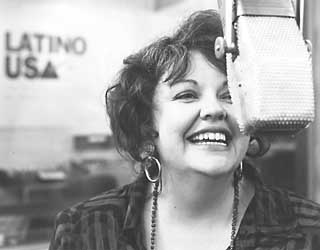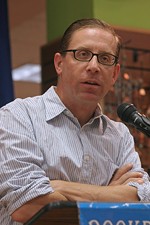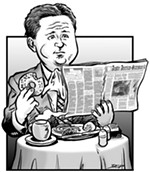Media Clips
Voice of Authority: Latino USA Stands on Its Own
By Lee Nichols, Fri., Sept. 17, 1999

One of the great mis-takes journalists make is waiting around for some sort of hook to peg a story on. Waiting for a hook can often blind us to the fact that excellence alone is a good enough reason to write something up. Under that theory, the series of special episodes planned by Latino USA for Hispanic Heritage Month is the angle that finally moved that KUT-based radio program onto the front burner of "Media Clips." But that's not the real story -- what's really worth noting is that in its six years of existence, Latino USA has consistently produced solid journalism and has quietly become an important show among National Public Radio's offerings. In these days of minority underrepresentation in the media, it has provided a badly needed voice on the nation's airwaves and made an impact beyond public radio's confines.
In conjunction with the University of Texas' Center for Mexican-American Studies (CMAS), the show was developed in 1993 by Maria Martin, then a 20-year veteran of public radio programming who specialized in Latino issues and who most recently had worked on NPR's short-lived Latin File, in 1988-89. In 1992, Martin learned that CMAS was planning to start a program, and she moved to Austin.
"That's when the Ford Foundation gave the center some seed money to start the program. I was hired to develop and produce it," Martin says. "We were a small staff at that point, and it took me a year to come up with a format, develop a network of reporters, and develop a pilot to send to stations."
The program went on the air in April 1993 and by the end of the year had 100 stations on board.
"We've done 300 shows since then," Martin says -- 334 to be exact -- including, of course, on KUT itself every Friday, 3:30-4pm.
"In English-language broadcasting, there is no other medium that does what we do," Martin says -- "to tell the Latino story, and tell it from a Latino perspective. We do stories about the Latino community, and we also do more general stories looked at from the Latino perspective."
The magazine-style show runs a broad gamut of political and cultural topics. The most recent edition included a report on the amnesty President Clinton granted to Puerto Rican nationalists convicted of terrorist bombings, a report on the ongoing effects of Hurricane Mitch on Central America, and a feature on a country singer who incorporates Cuban music into his repertoire. Martin is especially proud of the coverage of Mitch, as it exemplifies how Latinos might have a different perspective on what constitutes important news.
"After Hurricane Mitch destroyed the infrastructure of Central America last year, and then after it fell off of front pages, we wanted to continue to explore what was happening there. The area's development was set back about 60 years, and we wanted to explore how the government was reacting to that and what happened to the aid, and so we have been doing a special series looking at Central America in the wake of Mitch. We had three reporters who went to Nicaragua, Honduras, and I went to Guatemala."
But why base the show out of Austin, instead of a more traditional media capital?
"I think it's just because we came up with a viable proposal," Martin says. "I got a letter from [former KUT publicist] Yolanda Felton saying that she had presented to the center (CMAS) a proposal to do Latino-oriented programming. At that point, I had been involved in probably every single Latino-oriented radio project in some way or another. I had never headed one, but contributed in some way. All those programs had their run and ended. I was concerned that if this project were to happen that it not re-create the wheel, but that it [use] the maturity [which] Latino journalists in public radio had to offer, and that there could be a program that wasn't necessarily seen as NPR's guilt offering to the Latino community -- that we could do radio so compelling that it could stand on its own, a contribution to the format of public radio that could be as good, if not better than, anything else.
"I knew we were up to it, but an institutional bias had been developed in public radio by projects that were not necessarily ill-conceived, but not conceived as well as they could have been. I suggested that KUT interview and talk to all these other projects and that the project formed would be informed by past experience."
Also, Martin says, "The fact that it was at UT, with its institutional support, and the fact that it had a connection to a research center with connections to a larger research consortium appealed to the Ford Foundation, and to me. I thought the type of wonderful research that goes on at UT sometimes had a very narrow audience. Here, there could be a marriage between media and academia that would popularize and give a broader use to all the research and books and wonderful thinking at UT.
"I do have to say, I've worked in public radio for 20 years, and this staff at Latino USA is just one of the best groups of people anywhere. One of the reasons the program is successful is that it sounds good. It not only informs, but it's entertaining, compelling radio. -- [KUT's] Walter Morgan is a wizard of an engineer, and KUT has been extremely supportive."
Of course, since Latino USA's founding, there has been an explosive rise in for-profit Latino-oriented media.
"In many ways we were a pioneer," Martin says. "Hispanic magazine hadn't yet moved to Austin, and there were not the slate of magazines out yet. [The new media] provides a challenge for us to continue doing quality journalism and to promote the program in the same way commercial media does, and to explore other niches of information that need to be filled."

If the commercial media has impacted Latino USA, there has also been one major reciprocal impact -- program host Maria Hinojosa is now known to CNN junkies as one of that network's top reporters.
"She was on NPR as a correspondent when we were developing the program," Martin says of Hinojosa. "Because of the institutional bias, we wanted to do something that would work and wanted a voice that would be recognized. She'd been there since 1990, and we made a deal with NPR that would allow her to host when she was their New York correspondent."
Eventually, CNN made Hinojosa an offer, but her duties with them still allow her to host the show. "Being on CNN is mutually beneficial to the show and to her, to still have a foothold on public radio. It hasn't hurt us, that's for sure. She's one of the elements that makes the show successful."
Summing up the show's purpose, Martin says, "What we saw as a void when we went on the air was lack of understanding of the Latino reality among a wide number of people, including Latinos themselves. Among the general population there are stereotypes, and not an understanding that Latinos have been in the U.S. since before 1776, that Latinos are not just immigrants, not just farmworkers, not just Spanish-speaking, not just brown. We are diverse and complex. That misunderstanding has crossed over to different Latino ethnic groups. Perhaps Mexicanos don't understand the Puerto Rican experience. We can be a bridge of understanding. In our program, even though we are based in Texas, we want to be a reflection of Pan-Latino reality."
The four upcoming specials for Hispanic Heritage Month (Sept. 15-Oct. 15) should accomplish that goal. Breaking away from the usual radio magazine format, each episode will focus on a theme. The Sept. 17 edition examines the relationships between Latinos and Native Americans in New Mexico and the Filipino community; Sept. 24 focuses on the unique challenges of Latino parenting; Oct. 1 looks at how Latino youth incorporate aspects of other cultures, especially African-American; and Oct. 8 spotlights "Living Legends of Latino Music," including Afro-Cuban jazzman Mongo Santamaria, Puerto Rican percussionist Tito Puente, and Lydia Mendoza, the first major female star of Tejano music.
"When we first went on," says Martin, "[against] that institutional bias, we proved that with a good product people will listen. It's not a program that balkanizes, but helps the general community to understand. One station manager said to me that Latino USA is like being in a Latino living room. It made him feel like an honored guest. I think that's what we wanted."
For more on Latino USA, including RealAudio files of back editions, check out their Web site at http://www.latinousa.org.
The Road Riddle The war that nobody wants to fight continues. Well, nobody but the Austin American-Statesman. And once again, editor Rich Oppel and his editorial-writing cohorts have shown that they are either woefully ignorant or completely disingenuous. Whichever it is, the effect is the same.
The Statesman, in what has practically become a regular feature in its ironically named "Insight" section, loaded up both barrels of its shotgun last weekend and blasted away.
The first barrel -- the unsigned editorial -- tried to convince us that the latest attempt to build yet another highway over the aquifer is really nothing to worry about. Texas 45, an almost three-mile stretch which would connect FM 1626 with MoPac, would simply be used to divert gravel-hauling 18-wheelers away from the schools in the Shady Hollow neighborhood and thus potentially save the lives of precious children, the Statesman insists. Obviously, those mean old environmentalists just don't care about children.
And besides, those suburbanites aren't evil, the Statesman insists -- they're nice folks who served the writers some catfish, and they say they're really environmentalists. But of course, it's easy to find people who say they're against trashing the environment -- it's like saying you support world peace and an end to hunger. But finding people who actually understand the cause-and-effect relationship of road-building to sprawl is more difficult.
That's a shame, because it really is quite simple -- roads create development. Build it, and they will come -- this axiom has been proven by the very existence of neighborhoods like Shady Hollow and Circle C, and even more by loop after loop built in Dallas and Houston. Sure, the people of Shady Hollow probably won't drive around on Texas 45, and initially, there won't be much other than 18-wheelers on the route.
But then office buildings will start going up. And homes. And then, once again, we'll be back into this cycle of having to offer incentives to developers to stay off the aquifer.
If the editorial board is really committed to these "community meetings" they keep having, I suggest they meet with some of the people who have had their wells fill up with silt over the past decade from such development.
The right barrel -- Oppel's increasingly knee-jerk column -- again shows just how much we enviros hate little children by single-handedly causing the daycare crisis in Austin. No, the fact that Austin is the second fastest-growing city in the nation has nothing to do with the shortage of daycare in town -- instead, Oppel tells us, it is a city bureaucracy that insists on carefully scrutinizing the impact that projects (in this case, a proposed daycare center) might have on rain runoff. Never mind that the unwieldiness of the bureaucracy was inherited from less enviro-minded councils, and that the current green council itself is moving toward streamlining the city's development process. No, we should just stop trying to regulate growth altogether -- "Why doesn't the city just get out of the way and let the marketplace work?" he asks.
Simple, Rich -- because we've already tried that. That's how we got loops and rampant development out in the Hill Country; highways, offices, and neighborhoods over the aquifer; and disastrous floods along many of our urban creeks. ![]()
Media tips: [email protected]
Got something to say on the subject? Send a letter to the editor.








